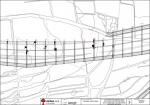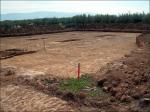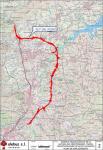Summary (English)
The site of L’Alt del Punxó was identified during the construction of the Mediterranean Motorway, specifically on the stretch of Cocentaina-Muro de Alcoy. The archaeological intervention carried out in 2008 documented diverse archaeological levels and structures dating from the Iberian period. The work was focused on detecting building structures without excavating them. Therefore, the conclusions are still preliminary, especially in relation to chronology.
The detected constructive remains relate to structures whose morphology is still difficult to define considering its state of preservation, the limitations of the intervention, and the methodology aimed solely at detection. The site with archaeological remains covers an area of approximately 0.6 hectares, although it could be larger considering that the documentation is limited to the area affected by the route of the motorway. The presence of diverse structures on the eastern boundary suggests that they extend further to the east.
The housing structures are distributed in a dispersed and isolated manner despite the fact that an axis or main road is set out, orientated from NE to SW, on which the dwellings are side by side, leaving ample empty space on each side. The structures lie on the sterile silty clay soil, in which graves were excavated. The walls of the houses were built inside these graves. There are two different types: cabins for temporary use and others whose walls seem to have evolved into a more stable dwelling.
The recovered ceramic items correspond mainly to the Full Iberian period, around the 4th and 3rd centuries B.C. However, items dating from previous periods have also been recovered (one from the early Iron Age, dated between the 7th century and the first half of the 6th century B.C and another from the early Iberian period from the second half of the 6th century- 5th century B.C.).
In summary, the documented remains demonstrate the existence of an Iberian settlement with dispersed urbanisation on both sides of a longitudinal SW-NE axis. The housing structures are cabins which, in some cases, later developed into consolidated houses. The main period of occupation is during the 4th and 3rd centuries B.C., although the overlays indicate a more prolonged existence. It was most likely a village dedicated to the agricultural exploitation of its immediate environment.
(translation by Alex Redmond)
- Eduardo López Seguí y Rosalina Barber Escoda
Director
- Eduardo López Seguí, Jesús García Guardiola, Palmira Torregrosa Giménez e Israel Espí Pérez
Team
- Fernando Gomis Ferrero (Alebus Patrimonio Histórico, S.L.)
Research Body
- Diputación Provincial de Alicante, Museo Arqueológico de Alicante (MARQ)
Funding Body
- UTE Corsan-Corviam, S.A. – Vías y Construcciones, S.A.






![Download [PDF]](/excavation/skins/fasti/images/results/download_sml.png)

